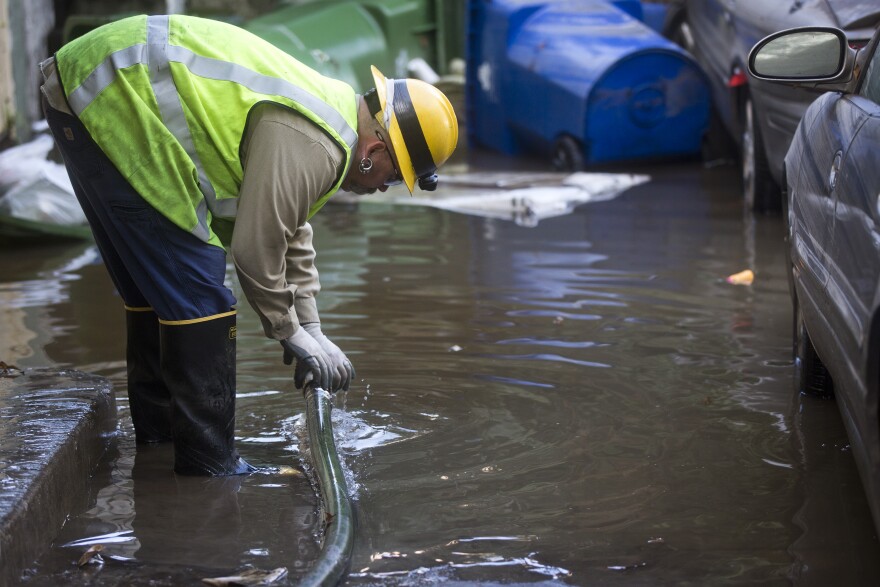With our free press under threat and federal funding for public media gone, your support matters more than ever. Help keep the LAist newsroom strong, become a monthly member or increase your support today.
7 things to know about LADWP's new rates proposal

Why does Los Angeles Department of Water and Power want to increase rates?
The nation's largest municipal utility says it needs to raise $1.13 billion over the next five years. That money would enable it to borrow an additional roughly $17 billion to replace aging water pipes and power poles, to increase local supplies of water to replace expensive imported water, and to wean the city off coal power in favor of renewable energy sources. DWP officials say they will spend 85 percent of the money on construction projects to improve water and power.
Some of the increase will be used to beef up and improve the agency's customer service staff, so phone calls can be answered within about 30 seconds, versus the two-minute waits that customers now experience, DWP general manager Marcie Edwards said.
How much will my water bill go up?
That depends on how much water you use. Lower water users will see a lower percentage increase in the monthly bill. You can check to see how much more you would be paying by using the DWP's rate increase calculator. It's an Excel spreadsheet into which you can put your zip code, lot size and monthly water usage listed on your bill.
If you're a water miser using only about 800 cubic feet per month (8 HCF/month), your water bill will go up about 1.4 percent or about 58 cents per month in the first year. That works out to about $7 more over the first year, or about $35 more over all five years of the increase.
The DWP's typical water customers, those who use about 1,200 cubic feet per month (12 HCF/month), will see a 3.8 percent or $2.46 monthly increase the first year. Those users will pay about $30 more per year. Over five years the increase for these customers amounts to over $150.
The highest users, those who consume 2,700 cubic feet per month (27 HCF/month), would see a 6.1 percent or $10.33 monthly increase, paying about $125 more each year, or about $620 over the five years of the increase.
How much will my power bill go up?
The power increases are similar to the water increases -- the less you use, the smaller percentage increase in your monthly bill. New increases will be tacked on each of the five years of the increase.
The lowest power users, say, those using 250 kilowatt hours per month, would see a 2.5 percent increase, about $1.37 per month. Midrange users consuming about 500 kilowatt hours would get a 3 percent increase, or $2.25 per month. The top tier users who consume about 900 kilowatt hours per month would have a 4.7 percent monthly increase, about $7.31 more.
I live in the Valley where we have big lots that need more water and hotter weather that requires more air conditioning. How do these new rates take our specific environment factors into account?
The DWP already divides its customers into hot and cool climate zones by zip code, and differentiates rates to take lot size, temperature zone and time of year for watering requirements into account. For example, a person who wants to conserve enough energy to be in the DWP's lowest billing tier would be limited to 350 kilowatt hours of power in a cooler zone, but be permitted up to 500 kilowatt hours in a hotter place, like the San Fernando Valley.
The DWP transfers more than $250 million a year in ratepayer money to Los Angeles for the city's general fund. Why doesn't DWP just use that instead of raising customers' rates?
That annual transfer is pretty controversial. A local group of ratepayers has sued the city to stop it on the grounds that ratepayer money should be charged only to cover the cost of the water and power services provided. The utility defends the transfer as permitted under the city charter.
However the lawsuit turns out, that money isn't nearly enough to cover the $17 billion in projects that DWP says is necessary to upgrade and replace crumbling water pipes and old power poles.
I have more questions about the rate increase proposal. Who's got answers?
You can ask the DWP how your own home rates would go up based on your water and power usage by calling 1-800-342-5397. However, DWP would prefer customers start by looking up their rate information at www.myladwp.com and using the "Contact" link at the bottom to ask questions and get an individual response.
Top DPW officials are presenting several community briefings in November before the agency's governing board is scheduled to vote on the increase. They are scheduled at locations around the city, and one will be streamed online.
What's next?
The DWP's governing board will meet in mid-December to take up the rate increase -- taking into account the public's comments about the proposal and an analysis expected from the independent Ratepayer Advocate office. The board could vote at that meeting or a future meeting.
The proposal then goes to the City Council for a yea-or-nay vote that's expected early next year.








